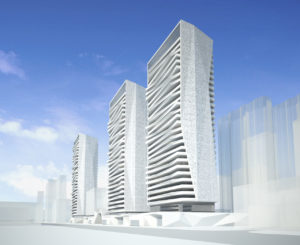Entering the architectural world of Gisue Hariri is like entering a new world of design possibilities immersed in history, creativity and art. Filling an entire wall with accolades and architectural awards Gisue Hariri and Mojgan Hariri’s modernist designs attest to their unique ability to combine their creative eye with their rich heritage and contemporary cultural, technological and environmental trends. Sisters and partners in Hariri & Hariri Architecture, are Iranian born but rooted in New York since 1986. Gisue Hariri discussed the ancient Persian Philosophy she grew up with and her respect for the natural elements of life such as Earth, Wind, Water and Fire. The practice has a poetic combination of various Eastern and Western influences like Rumi and architect Corbusier that have shaped their work, yet it remains exceptionally modern and a testament to their worldview that the human soul needs to be nourished and elevated.
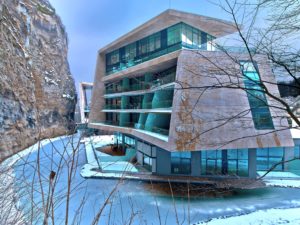
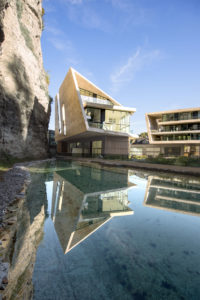
RS: Did growing up in Iran impact your architectural design at all?
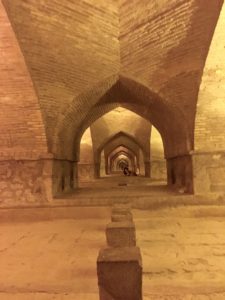
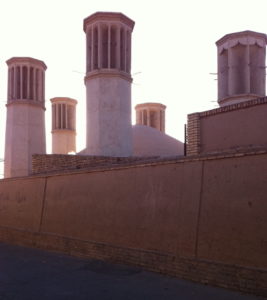
GH: I believe so, as we carry a lot of memories within us. Persian architecture has under it’s umbrella art, poetry, science, geometry, and craft. For this reason their architecture is very multidimensional, meaningful and impressive. Every summer we visited my father’s hometown of Isfahan. I remember walking through the pedestrian bridges and beautiful Persian gardens that are truly like Paradise. Earthen structures with turquoise-blue handmade tiled domes and surreal meandering narrow alleyways all were very special and made an impact on our soul & psyche. The contrast of materials and simplicity of earthen walls against the sophisticated geometric domes, vaults and archways of colored tiles is all rooted and connected back to nature and it touches you beyond it’s physical structures.
The Persians celebrated and respected natural elements such as Fire, Water, Wind and Earth. I think it is this respect for what is really the most essential, elemental things that create life which comes through their architecture that touches one the most. It is ultimately all about respect for the natural environment and connection between man and nature.
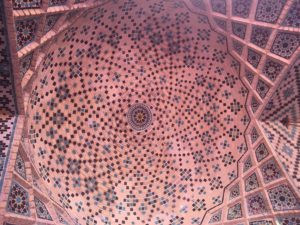
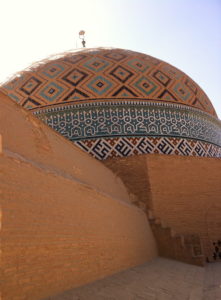
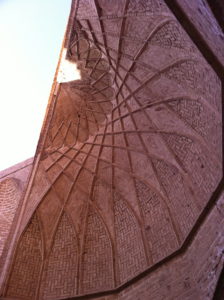
RS: Why do Iranians have that connection between nature and design?
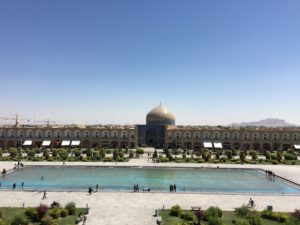
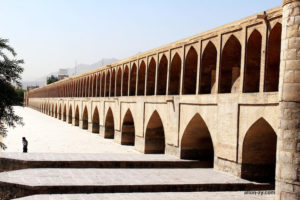
GH: I think the early Persians understood the value of nature and sacred natural element for survival of the body and spirit and in fact started building temples to maintain the eternal fire burning as a supreme symbol of purity.
Water (drinking & agriculture) and wind (air) were used in the early earthen architecture and the structures. Part of Iran is a desert with very severe conditions, dry and arid. When one lives in those conditions one learns to be aware of everything specially the sparse surroundings. You learn to be frugal and sustainable and to respect what you have and what you can use very carefully. What is also surprising is the amount of technologies that the Persians had invented and were using for example In the early part of the first millennium B.C., they started constructing elaborate tunnel systems called qanats for extracting groundwater in the dry mountain basins of present-day Iran. The main qanat tunnel sloped gently down from pre-mountainous alluvial fans to an outlet at a village. From there, canals would distribute water to fields for irrigation. These amazing structures allowed Persian farmers to succeed despite long dry periods when there was no surface water to be had. Before freezers the Persians were making ice in shallow pools that were well shaded during the day by surrounding walls. The most amazing and simple technology is the use of wind for cooling and ventilation. This was done with a windtower (wind catcher) a traditional Persian architectural element that is designed to create natural ventilation and cooling in buildings. I actually experienced sitting under one of these wind catchers in an old building in my last trip to Iran. The volume of cool air under that wind tower in through out the whole house was memorable experience and very hard to explain. It is this kind on ingenuity, inventiveness, insight and intuition that inspire us. The awareness of precious life around us, and the respect for all things is a Persian value that we carry within us manifesting in all our architectural and design work. I truly believe that there is so much more to be learnt from these ancient cultures that have existed for thousands of years and encourage the schools of architecture to examine them more carefully.
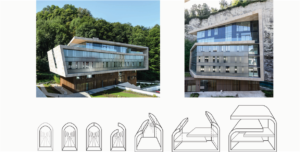
RS: Do you ever draw on that when you’re designing?
GH: Absolutely. We pay a lot of attention to all these elements, concepts and resourcefulness that we have experienced back in the country we grew up in. I think our projects are very special in a way that they are extremely modern and cutting edge but yet very essence oriented and archetypal because of these experiences. Our designs are are on one hand very experimental and visionary using the latest of technologies but at the same time they are very poetic and philosophical. We bring the best of East & West together.
RS: What are the poetics you look for?
GH: Very few projects, structures, buildings, and spaces inspire us. When we are moved we ask ourselves why? What was it that inspired. We live and work in one the most fabulous cities in the world with a dense urban fabric and variety of buildings. What makes one building better than another one? Why do we remember some structures and not others? What qualities in architecture are poetic? I believe there is no formula or a set of standard answers. Sometimes It is this harmonic relationship between architecture & nature or a dialogue and a meditative experience that you create. At other times it is the poetics of technology or the magic of invisible, unspeakable light. It is what we cannot find in the books of architecture. Poetry in architecture is a quality we find within ourselves. For us architecture is more than construction of buildings, it is where our dreams transcend realities of life. It is a commitment that will carry you to places you had never dreamed of and know could exist before you began. Art & architecture to us is a global language that connects the humanity and brings us all together as one community.
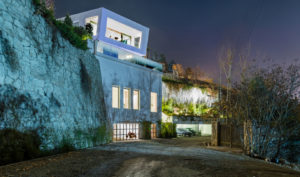

RS: Was it difficult overcoming sexism in your field?
GH: I had very supportive parents who believed in education specially for women. Here I was coming from Iran to USA to study architecture. Coming from a country that was developing and becoming modern. There were no women architects or role models to follow. The only thing I remember was that a beautiful young woman studying architecture in Paris was going to become the Queen of Iran. So, I believe that had an impact on me and in a way Queen Farah became a role model to a lot of young women including myself. The idea of coming to the United States and finding many women architects, gender equality and equity was very exciting to me. However, the reality soon revealed the similar unpleasant situation we had faced in Iran. Upon my arrival at Cornell I quickly realized there were very few women studying in the school of architecture and no women among the faculty. It was a shock to experience the “boys club” behavior and mentality in the school of architecture. Soon, I realized the whole education of architecture is based on a male thinking model with the lack of the intuitive and the poetic. There was no dialogue and one only learned about the opinions of one gender, male architects which often created very banal, rational grid structures and pragmatic boxes and called it architecture! It was truly a disappointing experience. What I learnt however was to examine everything and look within myself for answers and to find a way to express my own ideas and experiences in life. If architecture is about ideas and ideas are what we experience, then architecture that is created by women must be very different from architecture designed by men. Women experience and think very different than men. Our design approach and outlook on life is different, how could that not have an impact on what we create? The only way we can answer this question is by designing and constructing more projects and having more women architects and designers in the field. Unfortunately the architecture Media and the Award Juries are all corrupt and still most of the trophy projects and recognitions in architecture go to very few and in my opinion very mediocre architects and architecture.
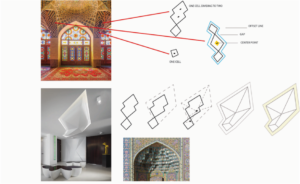
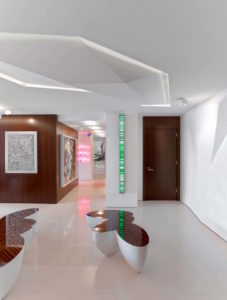
RS: What is good architecture?
GH: For us architecture cannot be defined as one thing, style, philosophy or ism. It is the amalgamation of many things, which at it’s best help us define who we are today and who we might be tomorrow. It’s the means of comprehending and encountering the invisible, where beauty, sensuality, functionality, technology and philosophy connect the body and mind. Great architecture is one that challenges our perception of life and living, helping us to find an alternative mode of seeing and acting upon the precious landscape. It is a commitment that will carry you to places you have never dreamed of and know could exist before you began your journey. It is where you find your inner voice.
Architecture is not a service or an answer to a problem. Great architecture is about setting up a great question or problem in architecture. It is about the history and identity of a place. I don’t believe in one style and one size fits all.
For the past thirty years it has been our firm belief that design is fundamental to improving quality of life and with an integrated, unified approach it can become a total work of art.
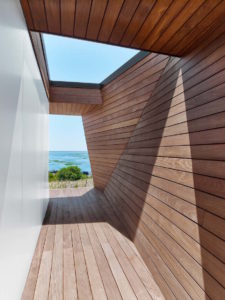
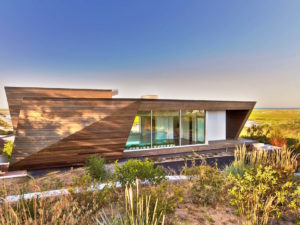
RS: What do you think about first when designing a building?
GH: We start with a concept and a challenging idea. What is it that we want to learn and see in the project beyond client’s requirement, program, budget, schedule, climate and site constraints. The challenge for us is what can we do that we have never done before. What can we invent that would be original, on the edge and yet acceptable by our clients. Believe me it is not easy to reinvent the wheel in every single project. It is difficult to tell people that Hariri & Hariri Architecture is not a supermarket where they can come in and purchase their project from the shelves. Every project is new concept, every site is a new challenge, every client is unique and every budget is limited and every schedule is extremely tight. However, when you find the right client and the project it is very exciting time for innovation and pushing the boundaries of architecture.
RS: When a project is a presented what are the first steps you do?
GH: The first thing we do is to go see the site. It is a must. Every site has unique characteristics, history, and challenges. We never look at the site & architecture as two separate things. I am always amazed at how builders and others want to buy our plans and build it on their property somewhere completely different.
Every piece of land has a different experience, different features, different surroundings. Where do you enter, where does the sun rise and set, what are other structures near by. The topography of the land, the physical & emotional experience of the place, and it’s history often generates the architecture that would be appropriate for that place.
RS: It must be an emotional experience?
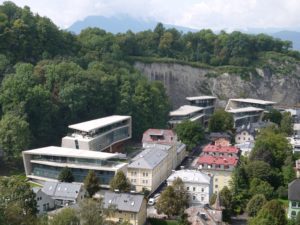
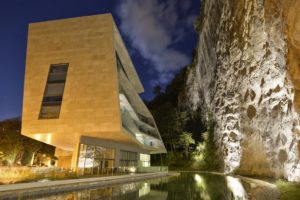
GH: It is a pretty spiritual experience. How could it not be emotional? What can be more important than creating and building a structure on a site? It is the relationship between the architecture and nature and the idea that the building has to belong to its site that is important. As Frank Lloyd Wright describes it, it’s a belief that the natural life that exists in a space should flow into, peacefully coexist with and benefit from whatever is constructed there. Or “No house should ever be on a hill or on anything. It should be of the hill. Belonging to it. Architecture is how we connect to the earth and the sky.
RS: It is a very philosophical approach
GH: Great architecture is philosophical.
RS: Was there a project you found particularly rewarding?
GH: All our projects are rewarding. I don’t remember a project we have worked on that I could say was not rewarding. Our “JEWELS OF SALZBURG” project has been one of our most challenging & rewarding projects. This project which we won in an international competition is important to us not only because we were the winners among the world’s best known architects such as Souto Moura (Portugal), Snøhetta (Oslo), Kengo Kuma (Tokyo), Yamaguchi (Osaka), Toshiko Mori (NY), Delugan-Meissl (Vienna), Langhof (Berlin) to name a few. This 80 Million Dollar Mixed Use development also demonstrates our “Holistic” philosophy where we have designed the master plan, the architecture of the six new buildings containing 100 luxury Apartments, renovation of existing historic vaults, some of the interiors, & the main landscape elements as well.
It is however neither the scale nor the challenges we confronted with the city agencies and the building codes that make our Salzburg project significant. It is the relationship between architecture & nature that we have created, a dialogue and meditative experience we have carved at the edge of the rock wall, which guides and invites the public along a creek on the edge of the site while providing privacy for those living there. For us Architecture is more than construction of buildings, it is where our dreams transcend realities of life. It is a commitment that will carry you to places you had never dreamed of and know could exist before you began.
Finally this project is one of the very few new constructions permitted in the historic city of Salzburg, offering Mozart’s birthplace a destination for the architecture of the 21st century.
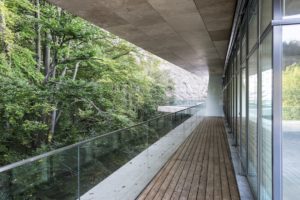
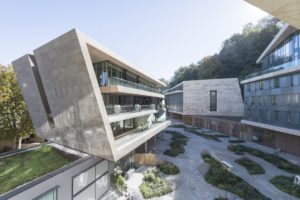
Another recently completed and very rewarding project is an office tower in a dense urban fabric. Unlike the Salzburg project the site of this office tower was very centrally located in the hearth of business /commercial center of Tehran and highly visible from the Argentine Square near by. The challenges here were very different. We asked ourselves how does one create a new architecture within a culture so rich in its art and architecture. How does one offer a 21st Century architecture to an ancient civilization that has stayed behind and has been disconnected from the western world for four decades in a meaningful way? We proposed a Tower with Two Skins! Looking within the Persian Culture itself and not importing an architecture from the west.
What makes this 12 story- office tower iconic is its double skin exterior.
The inner skin is all glass and the outer skin is a shading devise made of aluminum and fabricated with the aid of 3D laser cutting technologies. The pattern chosen for this outer façade is inspired by cosmic symbol & motif of a Mandala.
This symbol used in sacred arts specially in Iranian music & architecture, is however
interpreted, abstracted and repeated on two sides as a geometric figure or the DNA of the architecture representing the universe. This pattern often used in Persian architecture is based on the intersection of the circle & the square symbolizing the connection between the heaven and earth. Interpreted & abstracted becomes a screen shielding the direct sun and heat from entering the interior spaces providing a sustainable environment.
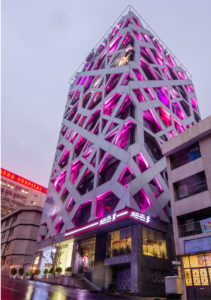
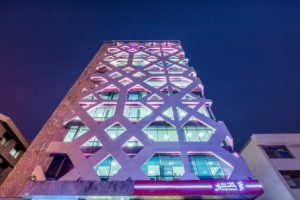
RS: You have your own students now, what advice do you have for rising architects?
GH: Architecture is war and if you are not a warrior you are not cut to be an architect. There are so many challenges and obstacles on your way to making an inspiring project. If you are not ready to face them with conviction and strength you might as well do something else. Architects contribute to the culture of the world. We travel to different places to mainly see their architecture, old & new.
I would also say that we have to nurture and create opportunities for women in architecture, as I truly believe that women have a lot to offer the field of architecture. We need to be mentors and sponsors to younger women architects. According to the Architectural record essay by Sarah Williams, Men still largely control architecture’s higher reaches. And they are more likely to lavish attention on younger men.
My advise to both men & women in positions of influence & awarding projects is to recognize that it is their responsibility to find & recognize women in architecture. The Media has a responsibility to publish and introduce the work of women architect’s to the larger public. The society as a whole has a responsibility to create equal opportunities for women architects.
